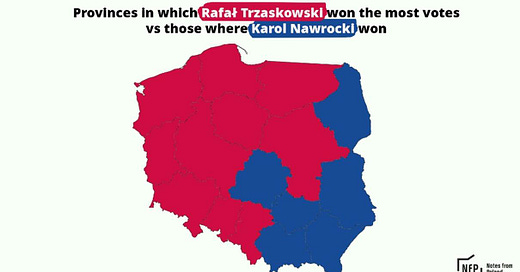Poland’s election – A critical turning point for the country?
This month saw a knife edge election in Poland, a rising economic power (2025 forecasts impressive GDP growth of c.3.5%) whose growth is outpacing larger countries, giving them greater sway over the EU’s strength and stability. The outcome… a narrow win by Karol Nawrocki, a right-wing candidate backed by the PiS (Law and Justice party) with no prior political experience (not to mention a colourful past as an alleged football hooligan), over Rafal Trzaskowski, a key ally of Poland’s Prime Minister Donald Tusk. The shift away from Tusk symbolises growing resentment towards the perceived inefficiency of his administration. When a coalition led by Tusk toppled 8 years of increasingly authoritarian PiS rule in 2023, there was a sense of renewal and optimism, but this has faded as most of his campaign promises, from economic to immigration pledges, have remained unfulfilled. It’s no surprise that Nawrocki’s rise has coincided with Poland’s growing nationalism, far-right sentiment, and loss of faith in the EU, which has been mirrored across Europe e.g., Germany, Hungary, and Slovakia.
The result further reinforces deep dividing lines in the Polish voting demographic. Sizeable divides exist between urban and rural voters - Trzaskowski taking 2/3rds of the votes in cities vs. Nawrocki taking 2/3rds of the votes in villages - and between the liberal West and conservative East, as the map below shows.
This could almost be seen as two countries within one, which gives you an indication of how difficult it is to govern, and partly explains why Tusk has struggled to implement his policies. Regardless of their divisions, the Polish public are highly engaged politically. This was the highest recorded turnout since democracy was restored in Poland in 1989 and was particularly strong amongst younger people - 18-29 year-olds were the second highest turnout group at 76.3%. Interestingly, Trzaskowski lost the support of young people, with an 11% reversal in votes from five years ago. It is clear younger voters were fed up with the lack of change under Tusk.
Nawrocki’s agenda is anti-Ukrainian support, extremely tough on migration, socially conservative, and anti-EU. His win thus has seismic implications for the future of Poland, which is likely to move further away from the EU and closer to a Victor Orban nationalist model (with Trump’s backing).
How this will play out over the next few years depends a lot on Poland’s power structure, with clearly defined and separate authorities between the President and Prime Minister. The President has a narrow legislative agenda vs. the Prime Minister but does have strong vetoing powers. These vetoes can be overridden by a 60% majority in the Sejm (lower house of Polish parliament), but Tusk’s lacks this majority, with 242 out of 460 seats. Tusk now faces a much harder path to drive through his agenda and achieve his vision of bringing Poland closer into the EU fold. His decision to call a confidence vote on the 11th June, which he comfortably won, is a clear sign of his concern. Calling an early election would be a high-risk strategy and would almost certainly result in a right-wing comeback. His only choice is to regroup, align on a common agenda, and try to deliver on his election promises. Time is running out and Nawrocki has given every indication he’ll exercise his powers aggressively to block Tusk. This stands to be a dogfight for power with the future path of the country hanging in the balance.
[We’d like to thank one of the co-author’s Polish colleagues, Krystian Cabaj, for his valuable and insightful input into this article]
Has Starmer lost his way? The government is backtracking and flip-flapping – the party’s strategy is increasingly confused.
As we have written previously, our current central case is that the UK economic picture is gradually improving. The government have played some role in that. Starmer has struck valuable trade deals with India and US, secured Brexit concessions with Europe (free movement of youth will plug labour shortages in key sectors such as hospitality) and managed Trump effectively to shield the UK from harsher tariffs. The economy is delivering on key metrics (GDP growth outpacing forecasts, business confidence rising etc). The recent spending review hit the right notes, prioritising infrastructure spend and the acceleration of housebuilding.
But in spite of this progress, Starmer’s strategy is becoming increasingly unclear and he’s at risk of not unlocking the UK’s economic potential fast enough. He’s losing the public as a result - his approval ratings have plummeted by around 12% in just eight months, the largest negative swing of any newly elected UK prime minister in the past 40 years. We argue this has been driven by three factors that should be focused on and be corrected – manifesto U-turns, a failure to deliver early progress against their core pledges, and an alienation of different voting groups, leaving it difficult to know exactly who he’s trying to appeal to and what their strategy is.
Manifesto U-turns. Starmer continues to deviate from his election manifesto. Many promises have been broken - scrapping winter fuel payments (which has now been nearly fully reversed), stating he wouldn’t increase NI (then raising employer NICs), the green prosperity plan reduced from £28bn a year to £4.7bn a year – and the list goes on. Failing to follow through on his word and / or caving in to public pressure suggests either poor analysis of policy implications and / or that he’s losing confidence in his plan. Either way, it creates confusion and signals doubt in his judgement, which the public see as weakness. The latest backtrack on welfare reforms is a further example of this.
A failure to deliver early progress. It’s still early days so we don’t want to over-egg this point, but let’s highlight it via a central part of their agenda, housebuilding. May’s construction PMI reading of 47.1 marked the fifth consecutive month of sector contraction, with the effect strongest on the residential side – new housing activity dipped to just 45.1. Recent data shows the number of planning approvals for new homes in Q1 2025 were the lowest for 13 years. The time taken for local authorities to finalise S106 agreements (a vital part of the planning process) with housing developers has increased by 20% in the last two years. These are alarming indicators. Urgent regulatory rollback is required as well as stimulating demand drivers like re-instating the ‘help to buy’ scheme. A key pipeline blocker is a lack of resources assigned to the Building Safety Regulator (BSR). This has been exacerbated by the need to pass through the onerous red tape of the Building Safety Act. Labour, despite promises of planning reform, have done little to address this blocker. Based on the current trajectory, the prospect of hitting their 1.5m target in 5 years is fanciful, but even if they could get to 1m over 5 years, which should be achievable, it would be a big step forward from here.
Losing their way strategically / alienating groups. Starmer is seeing the risk of Reform’s rising popularity and the clarity of their agenda (whether you agree with it or not). It’s causing him to take increasingly Reform-like positions – his recent claims the UK risks becoming a ‘nation of strangers’ if immigration isn’t controlled, the backtracking on capping bankers’ bonuses, and the recent proposal to mandate chemical castration for sex offenders all being examples. The recent welfare reforms, whilst necessary, will alienate some Labour voters. The ‘thread’ of his political judgement, his core beliefs, and his vision for the country are becoming harder to see. It’s no surprise that without a clear sense of who he’s trying to appeal to, his policies are landing badly and his popularity is falling.
Labour need to ‘own’ this false start, be transparent about how they fix it, and deliver a strong message on how these manifesto shifts and reforms (e.g., prisons, immigration) link to their overall strategy and central case.
Vance as the next (puppet) President with Trump pulling the strings… audacious but possible?
Trump has recently made several comments regarding standing for a third term. The main, most detailed one, was in an NBC phone interview covered in the clip below where he claims ‘so many people want me to do it’. His surrogates e.g., Steve Bannon are openly discussing the idea, causing heightened background noise on this issue.
https://www.nbcnews.com/video/trump-won-t-rule-out-seeking-third-term-235803717544
Whilst this may just be more provocation from Trump, trying to stir up a media reaction (he also recently said he wouldn’t do this), it deserves to be taken seriously. A third term would violate the constitution and set a dangerous precedent for future US presidents.
As it stands constitutionally, a third term is not possible. The 22nd amendment, put in place in 1951, after Franklin D Roosevelt served 4 terms says; ‘no person shall serve more than two terms’. Prior to Roosevelt it was just a custom for Presidents to serve two terms, not a constitutional stipulation. To change the 22nd amendment would require a 2/3rds majority in both the Senate and the House of Representatives. Recent events tell us Trump has no issue trying to circumvent the US constitution, with Laurence Tribe (one of the US’s leading constitutional scholars) saying ‘without doubt Donald Trump is the most lawless and scofflaw presidents we have seen in the history of the United States’. But in this case, we do not see it happening as (a) he would not have the votes in the House and (b) there would be plenty of time for the courts to outlaw it before he was named on the ballot paper.
So how could he get around it? The word we need to focus on is Vance.
Vance could stand with Trump as his Vice President. The two could then swap roles after the election. This could be done either overtly i.e. they could say they are doing this during the election campaign, or discretely after the election. They can’t formally swap titles and the VP doesn’t have designated authority over certain matters so it could only happen on the basis that Trump actually takes the decisions, so is VP in name only.
The Trump / Vance relationship and how this has evolved over the last year potentially gives us a few clues to what could be going on under the bonnet.
Vance was selected as Vice President by Trump in July last year. His speech at the Republican National Conference was far too “presidential” for Trump’s liking and in the months that followed, Trump’s shine towards Vance faded. A Bloomberg article entitled ‘JD Vance was supposed to be a MAGA heir. Now he is a liability’ encapsulated this mood music.
Wind forward and it’s clear Vance has now turned this around and regained Trump’s trust. Vance has been given more authority e.g., his controversial key note speech at the European Defence Conference, which kick-started Europe’s defence spending push. He’s made significant interventions at key moments e.g. in the Oval office at the Zelenskyy press conference, and it’s clear he’s a central figure in the White House inner circle particularly on foreign policy and defence matters.
The more latitude Vance has, the more chance he has to prove himself to the American public as a worthy candidate. But he stands no chance of winning without Trump’s backing. There would be no stronger signal of Trump’s support than to run on Vance’s ticket.
The factors begin to add up. This would be a mutually beneficial arrangement, clearing the constitutional hurdle, massaging Vance’s ego, and keeping Trump firmly in the driving seat. The US political power structures could once again be tested by Trump’s tactics. The public are already losing faith in constitutional enforcement, this would be yet another example. To avoid the chaos that unfolded post the 2020 election, this deserves closer attention. As we get deeper into Trump’s second term, keep an eye on how Vance positions himself for a run at the top seat as this could have seismic consequences.
Courting the Wealthy - Welcome vs Not Welcome….
There is a dividing line emerging amongst developed nations globally between those who court wealth and see it as an upside to many factors; tax revenue (some is better than none), investment, philanthropy, job creation etc, and those who don't.
In all the volatility around tariffs and the Middle East situation, less attention has been focused on this theme, which is bifurcating quickly, but yet again the focus is on a move made by Trump. He’s introducing a golden visa, also known as the Trump Card, which allows people to pay $5m for permanent residency and a path to citizenship. Never one to miss a self-marketing opportunity, his image is plastered across it…
As usual with Trump, the idea comes well ahead of the execution with few details, but there’s no denying the appetite - 70,000 people have signed up in a week. Assuming reasonable terms associated with the residency / citizenship, one can see how this could be a good idea for the US economy. The direct impact of 50,000 applying successfully would be a direct $250bn in tax receipts but the more powerful effect will be bringing wealth creators, tax payers and job creators into the economy.
Other countries have equally spied an opportunity here and are courting wealth. The UAE has a golden visa system aimed at ‘attracting global talent, entrepreneurs, professionals, students to foster innovation’. Their system is linked to the type of person / skills you have or alternatively the amount of money you can invest in the property sector. Close to 1,000 high net worth Britons were said to make the UAE their home last year with the most recent example being Britain’s richest person, Michael Platt (worth c$19bn) who shifted his domicile to Dubai.
Closer to home, Italy has a similar scheme based on an investment of €250,000 to €2m depending on the type of investment (from high risk start up at the low end to low risk bond investments at the higher end). New Zealand have also gone down this route with golden visas to attract wealthy foreigners.
These examples contrast starkly with the UK, where Labour have ideologically and dogmatically enacted their election promise to reform and restrict ‘non dom’ tax rules, historically a driving factor in attracting wealthy residents. This has resulted an exodus - Henley & Partners, who compile a Wealth Migration Dashboard show that close to 11,000 wealthy people left the UK last year, an 160% increase on year before. The Centre of Economics and Business Research estimated that a quarter of non-dom taxpayers leaving would wipe out the net gain to the Treasury. This effect is already well in train and we may not be far off that number. The UK’s GDP growth partly relies on wealthy staying put. This has again become a political focus – driven by the surge of the Reform Party / Farage, with his recent proposal to charge Non-Dom’s - £250,000 – to get a Brittania Card, which would then exempt non-UK income from the tax system. Reeves is beginning to waver, with suggestions she may U-turn on the IHT ruling for non-doms (placing them on the 40% rate, not the previous 20%). This is the right direction to go in, but it may be too late unless she acts quickly. Once they’re gone, evidence shows they’re unlikely to return. Reeves needs to look at the global direction of travel and realise she’s facing the wrong way……
Restaurant of the month: Yoshino
Yoshino was an iconic Japanese restaurant hidden in a back street off Piccadilly, close to Bellamy’s and Gaucho. It’s run by Lisa, a friendly host who creates a welcoming atmosphere. It had a very loyal client base. Around 3 years ago, the owners of the building decided to redevelop it and Yoshino had no option but to close.
Wind forward 3 years and about a month ago, it soft opened again in the space where Italian restaurant Al Duca used to be, just north of St James Square. It's a soft launch as the whole space will be refurbished in a few months to create the same feel and vibe of ‘Yoshino 1’. This will be a major enhancement to what they inherited from Al Duca.
And Lisa is back, which is great to see. She's been back and forth to Japan in the intervening period as she waited for a new site opportunity, but is excited to see ‘Yoshino 2’ back up and running.
The soft launch means the menus are still being honed, but the quality of the food remains excellent – whether it's sashimi, sushi, tempura or hot dishes e.g., chicken teriyaki.




The restaurant industry can be very unforgiving so it's great to see Yoshino bounce back from closure and soon be refitted in its old style. Bravo, we look forward to seeing it thrive once again.
Wine of the month: Vincent Dureuil-Janthial Rully Premier Cru Les Margotes 2022
In prior editions, we’ve shone a light on ‘fringe Burgundy’ wines from sub-regions where there’s high quality wines for reasonable price points – the Mâconnais and Côte Chalonnaise. As we’ve explored these sub-regions more extensively, one producer has stood out – Vincent Dureuil-Janthial, one of Côte Chalonnaise’s finest winemakers whose reputation grows each year. His distinctive labels are easy to spot, but more importantly his Rully wines are absolutely outstanding for the price. The bulk of Dureuil-Janthial‘s plots surround this small village, where he’s mastered organic farming techniques and maximised promising conditions (south-easterly, clay limestone slopes that mirror the more expensive plots of the Cote D’Or). This Margotes 1er Cru is one of his finest plots, showcasing the minerality and depth his wines are famous for. 2022 had a warm growing season resulting in richer, well-structured wines that retain their freshness. Stone and citrus fruits on the nose, playing through into a nutty, chalky finish – truly superb, a wine that seems 3x its price.







Another good newsletter, L&L. Thank you. Enjoyed the insight about Poland; something we Canadians don't get much information about. Keep up the insightful reporting. Thanks so much
Tony S